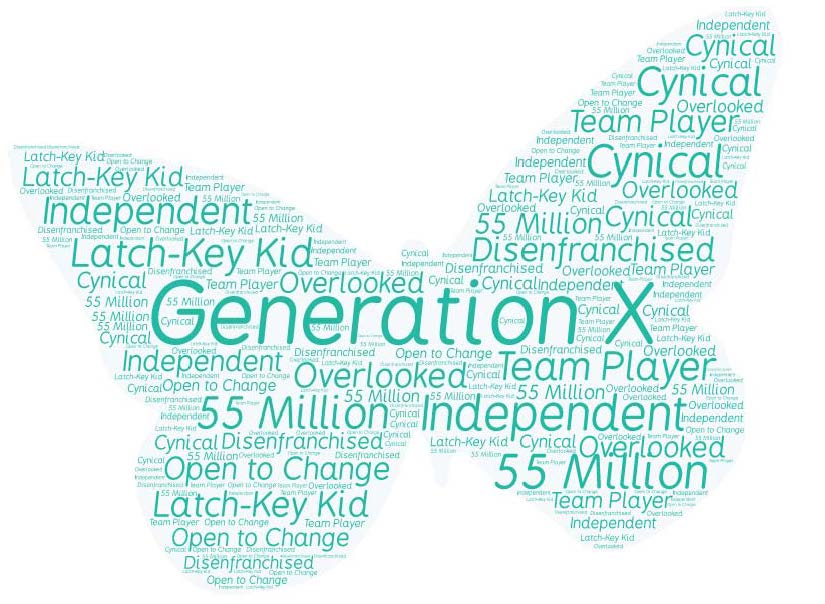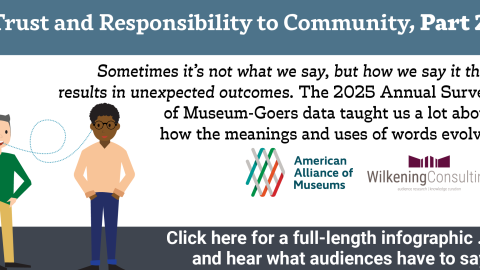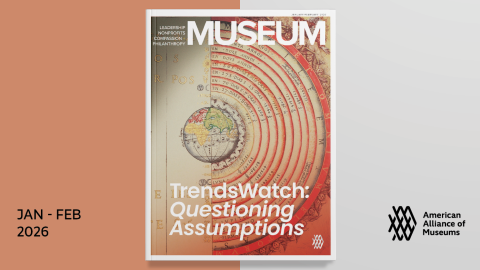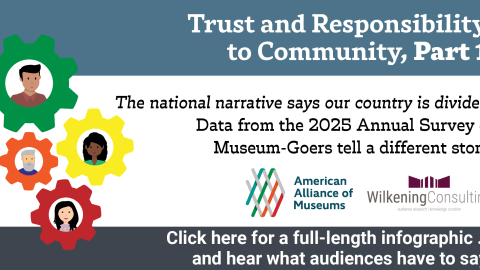
I distinctly remember being at a museum conference about 10 years ago, when I was a department manager but not yet at the senior level, and scanning the program to figure out where I fit in: the director sessions weren’t open to me, and with about 10 years of museum work under my belt at that point, the sessions aimed at emerging professionals were too basic. Because I worked at a small museum and had wide-ranging responsibilities, I didn’t only want to focus on one content area, like education. It was at that point that I started to think about Gen Xers in the field, and what resources I felt like I needed that I couldn’t find. Since then, I’ve been working to address this topic as part of an ad-hoc group of New England-based Gen-X museum colleagues.
Before I go further: a few disclaimers. First, it’s impossible to talk about any generation without reverting to some stereotypes. Certainly, each individual and his/her situation is different, and my conclusions are based largely on anecdotal evidence rather than any formal survey or study. Second, I am using the term “Gen-X museum professional” synonymously with “mid-career museum professional,” as most of the Gen-X museum people I know have been in the field for around 15-20 years. However, I realize that these terms are not necessarily interchangeable (there are mid-career professionals of other generations, and Gen Xers who have more or less experience than the mid-career definition).
Specific parameters vary, but Generation X is generally defined as encompassing people born between the mid-1960s and the early 1980s; the first Gen Xers turned 50 in 2015. We are a relatively small generation, with about 55 million of us born during our generation as compared to Baby Boomers (76 million) and Millennials (66 million). We came of age during the peak divorce rate in American history, and were much more likely than previous generations to have mothers in the workplace, hence the stereotype of the “latch-key” kid. Seen as disenfranchised and independent, we have been largely overlooked in comparison to the larger and more visible Boomers and Millenials.
At the risk of sounding melodramatic, I think that the overlooked potential of Gen Xers is a full-scale crisis in the museum world. Let me explain why, and then share some ideas about how we and our colleagues can address the problem.
First, I want to underscore the fact that Generation X is worth investing in. Generally speaking, we are at a stage in our careers where we are productive and efficient, likely with relatively little oversight required. We tend to be loyal, highly invested in our employer’s mission, and eager to have a positive impact. We are less likely to job-hop than Millennials, and better able to adapt to new technologies than Boomers. We are likely to be the keepers of significant amounts of institutional memory. We have many years of productive employment ahead of us.
Despite these good qualities, Generation X museum staff may not see a clear path ahead. Though more Boomers are retiring now, many of them delayed retirement in the aftermath of the financial crisis. If there is not a succession plan in place at our current institutions, we are likely at the stage (which Pew calls “the middle innings of life”) where we can’t pick up and move to a new city: we have mortgages, aging parents, kids in school, strong community networks, and partners/spouses rooted in their careers (which, frankly, probably pay better than ours). Many Gen-X museum staff I know feel at sea: they want to be directors but can’t find an appropriate opportunity; they don’t want to be directors but feel that anything else is a lateral move; and/or they don’t see opportunities for growth in their current jobs.
For these and for many other reasons, Generation Xers are leaving the field. While I don’t have hard data to support this (though a report—covering all generations—is forthcoming from colleagues), after 19 years in the field, I would posit that my anecdotal evidence is a reliable snapshot. I personally know scores of talented, committed, creative Gen Xers who have left the museum field and are not likely to return. While reasons vary widely from individual to individual and it’s hard to draw concrete conclusions as to why, what concerns me is that this is a silent exodus: once they have moved on to other fields (teaching, higher education, foundations to name a few), they no longer have a voice in the museum community, and their absence is not recognized. We need to keep good Gen Xers in the field, so we have seasoned professionals to step into the roles that Boomers are leaving.
The picture I’ve painted may seem bleak, but the challenges are not insurmountable. Here are a few ideas:
For Gen Xers:
Speak up for yourself. Millenials are better at this than we are, and we can learn from them. Toot your own horn, make yourself and your accomplishments visible, but do so in a way that feels authentic to you. You have nothing to lose and potentially much to gain.
Be creative and keep an open mind. While we grew up thinking that careers are linear, the gig economy is proving that that’s not true. It can seem unfathomable to step off the ladder, but it is worth considering whether another path – or even slight detour – could lead to new skills and insights.
Explore resources. An article I found particularly useful is Anne Ackerson’s Strategize Me: Making a Personal Career Plan, published in the March/April 2017 issue of Museum (excerpted from the book A Life in Museums: Managing Your Museum Career). Jenny Blake’s book Pivot: The Only Move that Matters Is Your Next One is another resource that several friends have found helpful.
Find each other. Though there are many groups devoted to young/emerging museum professionals, I don’t know of any that are specifically geared to Gen Xers (please correct me if I’m wrong!). It can be isolating to be part of a relatively small generation, especially if you’re at a small institution. Whether through informal meetings, online networks, or a more formalized group, connect with your peers. Comment here and share your ideas for how we can best network as a peer group.
For museum leadership and boards:
Notice your Generation X employees. We tend to be “heads down,” “workhorse” employees, and relatively low maintenance. We are probably under the radar, and are not likely to seek out attention. The stereotype of Gen X as the “middle child” (the “Jan Brady” of the generations) may ring true. We are almost comically overlooked: one person attending the NEMA session on intergenerational workplaces facilitated by a team of six Gen Xers commented that she wished there were a group who could bridge the gap between Millennials and Boomers. We are here. Coax us away from our desks, ask us our opinions, and we’ll likely have good insights that we wouldn’t necessarily have offered proactively.
Ask Generation X employees what they need, and do your best to provide it. Gen Xers are less likely than Millennials to ask for opportunities, but no less likely to need them. One common request among Gen-X colleagues I’ve spoken to is more coaching and mentoring for new directors. We may need flex time to address the “middle innings” we’re navigating. We may need specific training on management topics like HR (another request I’ve heard from multiple people). These things are doable, and not expensive, and will go a long way toward retaining good people.
Remember that there are different styles of leadership, and that Gen X’s brand may be different from the Boomer style that museum boards are likely to be more familiar with. That doesn’t mean it’s less effective. I love the point that “no drama” Barack Obama’s leadership style is characteristic of Gen X (though technically he is a tail-end Boomer): collaborative, deliberative, and able to compromise for the greater good.
Join me and my colleagues Elisabeth Nevins, Purvi Patwari, Dawn Salerno, Marieke Van Damme as we explore Gen X issues in the workplace at the New England Museum Association annual conference October 25-27 in Falmouth, Massachusetts.
About the Author
Tara is the Deputy Director of the Museum of Russian Icons in Clinton, MA, and is a faculty member in the Tufts University Museum Studies program. Her frequent references to Seinfeld are a dead giveaway that she is a proud member of Generation X.[/cs_text][/cs_column][/cs_row][/cs_section][cs_section parallax=”false” style=”margin: 0px;padding: 45px 0px;”][cs_row inner_container=”true” marginless_columns=”false” style=”margin: 0px auto;padding: 0px;”][cs_column fade=”false” fade_animation=”in” fade_animation_offset=”45px” fade_duration=”750″ type=”1/1″ style=”padding: 0px;”] [/cs_column][/cs_row][/cs_section][/cs_content]








Most insightful and it feels true. Facts, data need to be collected to authenticate these implications based on anecdotal information. It is inexcusable that a whole generation gets underutilized and unrecognized. The mentoring is possibly tricky with a group as described because they are unlikely to reach out to connect and the busy Baby Boomer leader is unlikely to take the initiative…stale mate.
Good point re: mentoring. Gen Xers probably need to be more proactive in forging these relationships. And/or mentor within our generation/with peers, which can also be useful.
Thank you for sharing these thoughts and perspectives! Your observations about different leadership styles, a call for more active mentorship & development opportunities, and encouraging Gen-Xers to toot their own horns with more confidence all ring especially true.
Thanks for commenting, Liz. I wonder how/whether the Generation X experience is different at very large institutions like yours vs. smaller ones, where we may not have any (or many) Gen X peers.
Also, consider how Gen Xers are excellent museum visitors, and should be courted: https://www.colleendilen.com/2016/08/31/three-data-informed-reasons-to-love-gen-x-visitors-to-cultural-organizations/
Yes — we are awesome in many ways! Thanks for your comment.
Generational Cohort Study has been around for some time. I remember reading in college the book, “Generations: A History of America’s Future” in about 1991, thinking as only an X-er might that this was hogwash. Finding the book later, I discovered a handy tool for managing expectations with multi-generational audiences.
One of the things pointed out by the book is that GCS can either go by the numbers or by observed affinity. Your point about Barack Obama illustrates this exactly. Taking the elevated number of births, the Boom Generation runs 1946-1964. Taking the observed affinity route advocated by the book, the Boom Generation runs 1942-1960, making Obama the first Gen X president. The book notes that those born near cut off points for generations will exhibit traits of their own and the adjacent generation. Obama was a marvelous mixture of Boom and X tendencies that both worked well together and caused visible clashes within himself.
Lastly, as encouragement to those making decisions, the book “Generations” notes that there are 4 generational types that repeat in the same order. Idealist (Boom), Reactive (X), Civic (Greatest, Millennial), Adaptive (Silent, Post Millennial) repeat. The X generations of the past included George Washington’s Liberty Generation and U.S. Grant’s Gilded Generation. In the case of past X-type generations of the past each survived its reckless youths to mellow into superb administrators (with the exception of US Grant’s 2d Administration, of course!) In my mind then, there is good reason for leadership to look deeply into Gen X for the mellow and superb for the brighter future they seek.
David,
Thanks for your comment. This is fascinating — I had never thought about how generational types repeat. I agree that Gen Xers can be “mellow and superb” administrators, and I hope this post (and comments) might help more museum leaders recognize that fact.
Yes! I can completely identify with what you are saying. I’m actually at the senior management level now, but I find the workplace to be challenging for our generation.
Thanks for commenting, Rebecca. I’d love to hear more about the challenges you’re seeing, and what you think the solutions might be.
Hi. I think we are a bit sandwiched between our older and younger colleagues. To be rather blunt, I find that supervising Millennials is extraordinarily challenging – I know I’m hardly the first person to point this out. Often they require extra attention, supervision, and praise. I find myself having to spend twice as much time as I used to directing and teaching that age group compared to, say ten to fifteen years ago, individuals in those same positions. Similarly, I think we often manage upwards with Boomers for different reasons. I find that a lot of Boomers are idealistic and spend a great deal of time on ideas that never reach fruition. Again, I think back to the beginning of my career and usually my bosses were not Boomers (they were older than Boomers) and did not need to be shepherded out of the land of ideas and back to the real world. I’m not sure how to improve things but I think this is a worthy subject to research and discuss.
Spot on, thanks (and thanks for the nod to A Life in Museums). We should chat sometime; this issue is right up my alley. gstevens@aam-us.org
Thanks for your comment, Greg. I would love to chat, and/or to help in any way with any AAM initiatives to take this topic further. Your session in St. Louis re: resumes for mid-career professionals was just the kind of hands-on, practical professional development we need more of.
I agree with you on every point here, Tara. Dawn and I had a conversation about this a few weeks ago in preparation for a two-hour discussion session that Kristin Gallas (Lowell National Historic Site) and I are co-facilitating at the September AASLH conference in Austin. Management training and mentorship are some of the big topics we hope to discuss. I hope the session will bring an intergenerational cohort of concerned history professionals to the table. Please let me know if you can think of ways that we can collaborate.
Thanks, Sarah. I’d love to hear more about what you and Kristin are planning for AASLH, and what the response is. Management training and mentorship are important topics. I recently was paired with a fellow Gen Xer as a mentor and found it so useful that he was able to relate to my experiences and provide peer-to-peer guidance.
BTW, we’re asking all the participants to read your post before they come to the gathering in Austin.
Tara, I’ll definitely let you know how it goes. (These comments all went to my spam folder, hence the delayed response.)
Tara, I find this a very fascinating topic and would love to discuss this even further. Despite being a millennial, I actually very much relate the topic at hand. I’ve been having this conversation with a few colleagues who span older millennial and gen X generations. How did the session go?